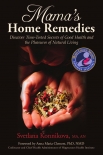Mama's Home Remedies: Discover Time-Tested Secrets of Good Health and the Pleasures of Natural Livin by Svetlana Konnikova (series like harry potter txt) 📗

- Author: Svetlana Konnikova
Book online «Mama's Home Remedies: Discover Time-Tested Secrets of Good Health and the Pleasures of Natural Livin by Svetlana Konnikova (series like harry potter txt) 📗». Author Svetlana Konnikova
“Even the Badger Knows…” @ 15
If you are curious by nature, conduct your own experiment with sphagnum. Place a piece of dry sphagnum in a glass jar with water and it will float on the surface like a cork.
To use sphagnum moss as bandaging material (don’t laugh; you might find yourself on a camping trip miles from civilization wishing you had paid attention to this), the moss must be soaked with water, wrung out, and dried before being applied to the wound. Do not allow the moss to dry to a brittle state because it will compress and lose its ability to absorb liquid. This little-known discovery made in pure desperation by a Russian doctor in 1919 can be developed today in research and perfected in preparation of natural materials for a treatment of wounds, ulcers, abscesses, inflammation, and burns.
It would likely be beneficial for our respected scientists to explore “the kitchens” of our grandmothers, midwives, and “witches.” Unfortunately my walking “Green Encyclopedia,” my grandma, has passed away, but I am thankful that my dear mother is alive, and she is there for me to consult regarding healing herbs and natural remedies. I consider myself the lucky heir to their extensive knowledge, which I began to document in a thick notebook when I was 12 years old. Day by day I recorded recipes and natural remedies that were passed down through the generations as treatments to prevent and fight disease. I read many medical books from Mama’s library and she shared with me her knowledge. I continue to consult with Mama, whose knowledge, even today, is extensive and focused on natural, effective, and harmless methods of green treatment. I have devoted my life to extensive research of the prescriptions and recipes of great ancient doctors. Today traditional, modern, and alternative medicines can no longer go each in their own way. We must learn to use them in synthesis, drawing from the best of each to reach their common goal—to
prevent and treat disease.
Avicenna, author of The Canon of Medicine,
lived in Bukhara, Uzbekistan. In some encyclopedias Avicenna (Ibn-Sina; 980-1037) is represented as a Persian physician and philosopher. The Canon
of Medicine is considered to be the greatest of all his prolific writing in theology, metaphysics, mathematics, and logic. It remained a standard medical text in Europe until the Renaissance.
16 ^ Mama’s Home Remedies
Avicenna relied on his own discoveries and adopted remedies from his ancestors—great physicians of ancient Greece, India, China, Egypt, Sri Lanka, Indonesia, and Africa. He also borrowed the wisdom of healers. While some may argue that the research on which he based his methods was ancient and no longer plausible in our current age of advanced technology, there is wisdom in the methods he employed that cannot be overlooked today. It is our choice to use our own judgment.
Avicenna did not hold an “authority’s” opinion above his own. He conducted his own experiments just as scientists do today. I do believe that he had more freedom to do as he wished than if he were employed by a powerful pharmaceutical company exploring the possibilities of the modern science of biochemistry. I sometimes imagine how Avicenna might function in today’s sterile, white modern laboratories with their state-of-the-art computers. He practiced nearly 40 years in the king’s palaces, in the shacks of poor workers, and in farm houses. During this time he had practical experience in using and validating the effectiveness of natural remedies. He approached these folk “prescriptions” from a critical point of view. After much research, he explained the nature and influence of various remedies on the patients’
physiology and illness.
Granted, as we read Avicenna’s words today, they may seem primitive, but thousands of years from today so will the ideas of our current scholars, scientists, and physicians. There is truth in the old saying that “the new is well-forgotten old.”
In an ancient Talmud it is written: “There is no leprous people and those suffering with pus in Babylon, because there the beets are eaten, the honey is drunken and people are washed with waters of the Euphrates.” Thousands of years separate us from ancient times. Today researchers affirm that the population in Iraq, contemporary Iraqis, consume red beets in big quantities. And statistics tel us that occurrences of cancer are minimal. But in a span between those thousands of years ago and our current age, Galen, Dioscorides, Hippocrates, Avicenna, and many other skil ed physicians of ancient times also knew about the medicinal properties of beets and used them as a natural healing medicine in treating diseases of intestinal properties and lymphatic glands, anemia, fever, nettle-rash, and putrid (putrefactive) and malignant sores. Scientific studies have proven that the ancient doctors were correct in their evaluation of the effective medicinal properties of red beets. It was established
“Even the Badger Knows…” @ 17
that beets contain cel ulose, apple, lemon, and other biogenetic acids which increase peristalsis of





Comments (0)